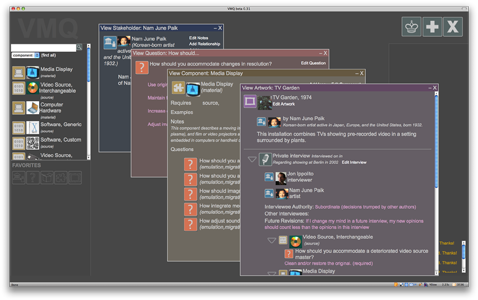 Graduate students in the University of Maine’s Digital Curation program do more than read archival theory and study metadata standards. As their final project for DIG 550 (Digital Preservation), several students chose real-life artworks to preserve using the techniques learned in class.
Graduate students in the University of Maine’s Digital Curation program do more than read archival theory and study metadata standards. As their final project for DIG 550 (Digital Preservation), several students chose real-life artworks to preserve using the techniques learned in class.
Kristin Segura interviewed artist Tim Tate about his work Four Seasons, a video installation with glass sculptural elements that evokes seasonal rhythms. Lisa Schamess chose Re-making Moby Dick, a complex multi-media storytelling performance coordinated by Trish Harris and Lissa Holloway-Attaway that invites the public to revisit each of the 135 chapters of Herman Melville’s 1851 novel in modern media. Both works present some of the challenges found in the digital era, from potentially obsolete video formats to Web standards to performance documentation.
 Segura and Schamess are conducting this preservation research under the aegis of the Digital Curation program, which just unveiled a much-expanded Web site. This online graduate program will be offering two courses beginning the first week of September. Debuting this September is a course in Digital Collections and Exhibitions (DIG 540), which covers much-needed technical skills in MySQL and PHP. Taught for the second time this year is DIG 500 (Introduction to Digital Curation), which covers how digital artifacts are made, acquired into collections, and tracked, including legal and technical considerations.
Segura and Schamess are conducting this preservation research under the aegis of the Digital Curation program, which just unveiled a much-expanded Web site. This online graduate program will be offering two courses beginning the first week of September. Debuting this September is a course in Digital Collections and Exhibitions (DIG 540), which covers much-needed technical skills in MySQL and PHP. Taught for the second time this year is DIG 500 (Introduction to Digital Curation), which covers how digital artifacts are made, acquired into collections, and tracked, including legal and technical considerations.
The interviews are archived using the Variable Media Questionnaire, which records opinions about how to preserve creative works when their current medium becomes obsolete. Its users can compare these opinions as they vary by work, by interviewee, and by date. This tool is already in use by such museums as the Guggenheim and Whitney, archives such as the Langlois Foundation and Rhizome.org, and universities such as the University of California at Berkeley.
Under the rubric of Forging the Future, the Variable Media Network builds and distributes free and open-source products that boost access and aid in preservation. The aim is to help creators, conservators, and curators understand the possible futures that can be imagined for a cultural artifact, and choose the best among them on a case-by-case basis.
 The latest release of the Variable Media Questionnaire looks at artworks as ensembles of components–not to track sundry gadgets like cables or disk drives, but to understand the key elements of a work that are critical to its function, such as source code or media display.
The latest release of the Variable Media Questionnaire looks at artworks as ensembles of components–not to track sundry gadgets like cables or disk drives, but to understand the key elements of a work that are critical to its function, such as source code or media display.
Acknowledging the relational character of much contemporary art, these parts extend beyond hardware to include environments, user interactions, motivating ideas, and external references. Structuring the Questionnaire in this way makes it easier to compare different artworks created with similar parts.
Anyone can play around with a demo version of the Variable Media Questionnaire, or request a free account to the permanent version, at the link below.

It’s an honor to be part of this.
What I did with some of my summer: http://t.co/K3MYTUY75D for @DigitCurator on the re-making of Melville’s Moby Dick http://t.co/m84rRuwDbf
RT @lisaschamess: What I did with some of my summer: http://t.co/K3MYTUY75D for @DigitCurator on the re-making of Melville’s Moby Dick http…
Great #DIG550 projects! MT @stillwaternet When homework is real work: #DigitalCuration students preserve media art http://t.co/y6nXdjuN9E
RT @lisaschamess: What I did with some of my summer: http://t.co/K3MYTUY75D for @DigitCurator on the re-making of Melville’s Moby Dick http…
RT @stillwaternet: When homework is real work: Digital Curation students help preserve media art http://t.co/1xeuhRcJDl #DigitalPreservation
RT @jonippolito: RT @stillwaternet: When homework is real work: Digital Curation students help preserve media art http://t.co/1xeuhRcJDl #D…